The Workers' Village and Necropolis
This village was founded during the 18th Dynasty during the period of Tuthmosis I but continued to develop during the 19th and 20th Dynasties. Then it was abandoned and buried by desert sands, only to be rediscovered in the 20th century. As Zahi Hawass explains, "Deir el Medineh housed a specialized community, in this case the artisans and workmen who built and decorated the royal tombs of the New Kingdom. Located against the desert cliffs and enclosed within a wall, the village was divided by two parallel streets off which opened rows of deep, narrow houses. Each house had an entrance room which often contained a niche that served for the domestic shrines. Beyond lay a larger central room with a raised platform for sitting during the day and for sleeping at night. The back rooms could be used for storage or for bedrooms and included a courtyard that also served as a kitchen. A staircase led to the roof or a second floor and there were often small cellars dug below the floors for storing pottery or valuables" (97). The settlement contained about 70 small houses within the walls (more dwellings were outside the walls), all of mud brick with stone foundations. This community existed in isolation (food was delivered to them) because secrecy was necessary, given the nature of their employment.
The workers in this community also built their own tombs, much smaller versions of those they worked on in the Valley of the Kings. The tombs usually consisted of a chapel and a small underground room. Over their tombs, they often constructed a man-sized pyramid. The necropolis is on the mountain slopes in close proximity to the residential area.
|
Right: Hillside with tombs (note small pyramid entrance at left of photo) |
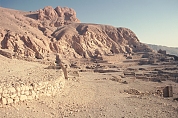
|
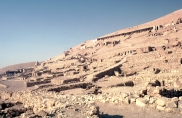
|
| |
|
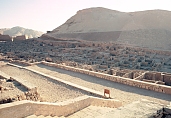
|
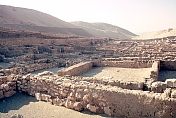
|
Village plan--Left: Steps up to hillside with the necropolis |
| |
|
The Temple
This Ptolemaic temple, north of the village, was built in the 3rd century BCE, and enlarged later. The name of the village Deir el-Medina means in Arabic "monastery of the town," a name given this area because it was occupied by monks during the early years of Christianity. The original temple was dedicated to Maat and Hathor, whose heads adorn pillars in the temple.Left: the Temple; center and right: the enclosure wall |
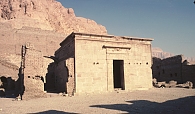
|
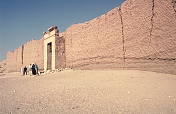
|

|
| |
|
The necropolis at Deir el-Medina: Tomb of Pashedu/Peshedu
Built during the Ramesside period, this tomb belonged to Pashedu who had the title "Servant in the Place of Truth on the West of Thebes." The small barrel-vaulted burial chamber is decorated.
|
Western wall of the burial chamberOsiris and Horus, in the form of falcons are on each side (not visible) in front of a large living udjat-eye supporting a torch. Below it Pashedu worships. |
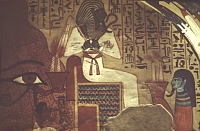
|

|
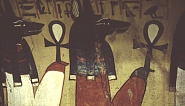
|
Left: Tympanum above the entrance with the god Ptah-Sokaris in the form of a winged falcon on a boat. The god is surmounted by a udjat eye and to the right, Pashedu worships (not visible). Right: detail of procession of gods |
| |
|
The necropolis at Deir el-Medina: Tomb of Inherkhau/Anherkha
Inherkhau, who had the title of "Foreman," lived during the 20th Dynasty, during the time of Ramesses III and IV. He was an overseer of the craftsmen of the tombs in the Valley of the Kings.
|
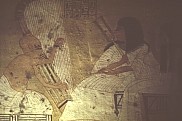
|
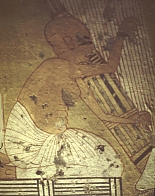
|
Inherkhau and his wife listen to the blind harpist |
| |
|

|
Scenes from The Book of the Dead and from the Book of Gates decorate this tomb. The "opening of the mouth" ceremony and below, right: detail of 10 priests (standing together in pairs) before the dead man (not pictured)
|
| |
|
Left: The cat of Heliopolis kills the serpent under the holy tree |
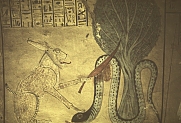
|
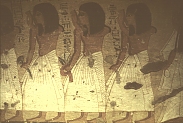
|


 Click here to go to the Egypt Index.
Click here to go to the Egypt Index. Click here to return to index of art historical sites.
Click here to return to index of art historical sites.
 Click here to return to index of artists and architects.
Click here to return to index of artists and architects.
 Click here to return to chronological index.
Click here to return to chronological index.
 Click here to see the home page of Bluffton College.
Click here to see the home page of Bluffton College.
